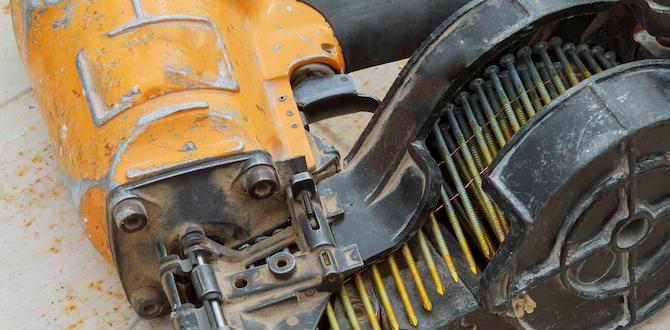Choosing the right air hose for nailers means matching diameter, length, and material to your specific nail gun and project needs for optimal performance and safety. A good hose ensures consistent airflow, preventing nailer jams and frustration, making your DIY tasks smoother and more enjoyable.
Hey there, fellow DIYers and woodworking enthusiasts! Jack Shaffer here, your go-to guy for all things nailers at Nailerguy. Ever felt that sudden drop in power when your nail gun just doesn’t drive a nail all the way in? Or maybe your hose is stiff, kinks up constantly, and generally makes your project feel like a battle with your tools. You’re not alone! Choosing the right air hose is one of those seemingly small details that can make a huge difference in how smoothly your projects go. Don’t worry, it’s not complicated. In this guide, we’ll break down exactly what you need to know, step-by-step, so you can get the best performance out of your nailer and make your woodworking dreams a reality. Let’s get those nails flying straight!
Table of Contents
Understanding the Basics: What Makes an Air Hose “Right”?
Think of your air hose as the lifeline between your air compressor and your nailer. It’s responsible for delivering a consistent, strong stream of compressed air that powers the tool. If your hose isn’t up to the task, your nailer won’t perform as it should. We’re talking about frustrating jams, nails that don’t seat properly, and a general feeling of “what am I doing wrong?” It’s usually not you; it’s often the hose! Getting this sorted means less hassle, better results, and a much more enjoyable DIY experience. We’ll cover the key factors: diameter, length, material, and fittings, to make sure you get it perfectly right for your needs.
The Importance of Air Hose Diameter: CFM and PSI Matters!
This is where things can get a little technical, but stick with me – it’s crucial! The diameter of your air hose directly impacts the amount of air that can flow through it. This is measured in Cubic Feet per Minute (CFM) and Pounds per Square Inch (PSI). Your nailer has specific requirements for both, and these are usually listed on the tool itself or in its manual. Your air compressor also has a CFM rating, and the hose needs to be able to keep up!
Why does diameter matter so much? Imagine trying to drink a thick milkshake through a thin straw. It’s slow, difficult, and you won’t get much milk quickly. An undersized air hose is similar – it restricts the airflow, leading to a drop in pressure. This means your nailer won’t have enough power to drive nails effectively, especially when you’re firing them rapidly.
Understanding CFM Demand for Nailers
Different types of nailers have different CFM demands. For example, framing nailers and roofing nailers, which are used for heavier-duty tasks and fire nails very quickly, require more airflow than a finish nailer or brad nailer used for more delicate trim work.
Here’s a general idea, but always check your specific nailer’s manual:
- Brad Nailers & Staplers: Typically require about 1-2 CFM.
- Finish Nailers & Pin Nailers: Usually need around 2-3 CFM.
- Framing Nailers & Roofing Nailers: Can demand 3-5 CFM or even more, especially during rapid firing.
Your air compressor’s CFM rating is just as important. It needs to be able to supply at least the CFM demand of your nailer. If your compressor puts out 5 CFM, but your framing nailer needs 5 CFM and you’re using a hose that restricts flow, you’re going to experience problems. The general rule of thumb is to choose a hose with a CFM rating that exceeds your nailer’s demand (and ideally matches or exceeds your compressor’s output) to ensure smooth operation.
Common Air Hose Diameters and Their Uses
Air hoses come in various inner diameters. The most common sizes you’ll see for DIY and woodworking applications are:
- 1/4 inch (6.35 mm): This is the smallest common size. It’s generally suitable for low-CFM tools like brad nailers, pin nailers, and small spray guns. While some basic finish nailers might work, you’ll likely encounter performance issues with faster or more demanding tasks.
- 3/8 inch (9.53 mm): This is the sweet spot for most DIYers and hobbyist woodworkers. It offers a good balance of airflow and flexibility and is ideal for finish nailers, framing nailers, and general-purpose air tool use. It’s the most versatile size.
- 1/2 inch (12.7 mm): This larger diameter allows for maximum airflow and minimal pressure drop. It’s best suited for high-demand tools, continuous use, or when you need to run multiple tools from one compressor. For most nailer users, this is overkill, but it’s excellent for impact wrenches and sanders.
Choosing the Right Diameter for Your Nailer
The golden rule: Match or exceed the CFM requirements of your nailer. For most common nail guns (brad, finish, framing), a 3/8-inch diameter hose is your safest and most effective bet. If you only use very small, low-power nailers (like a tiny brad nailer for upholstery), a 1/4-inch hose might suffice, but you’ll sacrifice future versatility. If you’re running high-demand tools or using very long hoses, consider 1/2 inch.
Pro Tip: Always check the recommended hose size in your nailer’s manual! If it doesn’t specify, err on the side of caution with 3/8 inch for general nailer use.
Air Hose Length: Balance is Key
How long should your air hose be? This is another factor that seems simple but has practical implications. Too short, and you’ll be constantly moving your compressor or yanking on the hose, which is frustrating and can be a trip hazard. Too long, and you can actually lose air pressure, especially if the diameter is also small.
The longer the hose, the more resistance the air experiences. This resistance causes a pressure drop, meaning less air reaches your nailer. For every 25 feet of hose, you can expect a small pressure loss. This loss becomes more significant with smaller diameter hoses and longer lengths.
Typical Hose Lengths and When to Use Them
- 25 Feet: Good for small workspaces, benchtop work, or when your compressor is always very close to your immediate work area.
- 50 Feet: A very common and versatile length. It provides enough reach for most DIY projects around the house, garage, or workshop without excessive pressure drop, especially with a 3/8-inch hose.
- 75-100 Feet: Useful when you need to keep your compressor further away, perhaps due to noise, space constraints, or when working on larger projects like decks, fences, or framing a small shed. For these lengths, a 3/8-inch or even 1/2-inch hose is highly recommended to combat pressure loss.
Calculating Pressure Drop in Air Hoses
While diving deep into exact pressure drop calculations can be complex, understanding the principle is easy. The longer the hose and the smaller its diameter, the more pressure you lose. Manufacturers often provide charts or calculators for this. For example, a 50-foot 3/8-inch hose will have less pressure drop than a 50-foot 1/4-inch hose. Similarly, a 100-foot 3/8-inch hose will have more pressure drop than a 50-foot 3/8-inch hose.
A good rule of thumb from the Engineering Toolbox suggests that for a 3/8-inch hose, a 50-foot length might result in a pressure loss of around 0.5-1 PSI for typical airflow. Doubling the length to 100 feet could double that loss. For a substantial pressure loss (e.g., 10 PSI), you’d typically need a very long hose combined with a small diameter or very high airflow.
How to Minimize Pressure Drop
- Choose the appropriate diameter: As we discussed, 3/8-inch or 1/2-inch hoses are better for longer runs.
- Keep the compressor closer if possible: If your compressor is too far away, consider using a smaller, portable pancake compressor for tasks that don’t require a lot of air, or invest in longer, larger-diameter hoses.
- Adjust your compressor’s output: You might need to increase the PSI setting on your compressor slightly to account for the loss in the hose, but be careful not to exceed the maximum PSI rating of your nailer or hose.
Air Hose Materials: Flexibility and Durability
The material of your air hose affects its flexibility, durability, resistance to kinking, and how it performs in different temperatures. This is a major factor in day-to-day usability and how long your hose will last.
Common Hose Materials Explained
- Rubber: Generally very flexible, even in cold temperatures, and durable. However, they can be heavier, more expensive, and might develop kinks more easily if not managed well. High-quality rubber hoses are excellent for demanding use.
- PVC (Polyvinyl Chloride): Often the most budget-friendly option. PVC hoses are lightweight but can become stiff and prone to kinking, especially in colder weather. They are generally less durable than rubber or polyurethane for heavy-duty use but are fine for light-duty, occasional tasks.
- Polyurethane: A good middle-ground. Polyurethane hoses are typically lightweight, flexible, kink-resistant, and quite durable. They offer a good balance of performance and price, making them a popular choice for DIYers and professionals alike.
- Nylon Reinforced: Many hoses, regardless of the primary material (like PVC or polyurethane), will have internal reinforcement, often a layer of nylon or polyester braiding. This braiding significantly increases the pressure rating, prevents bursting, and improves kink resistance.
Pros and Cons of Different Materials
Let’s break it down in a table for clarity:
| Material | Pros | Cons | Best Use Cases |
|---|---|---|---|
| Rubber | Very flexible (even in cold) Durable Good longevity |
Can be heavier May kink if lower quality Can be more expensive |
Professional use, frequent use, all-weather conditions |
| PVC | Budget-friendly Lightweight |
Stiff in cold Prone to kinking Less durable for heavy use |
Light-duty home use, occasional projects, budget-conscious buyers |
| Polyurethane | Lightweight Flexible Kink-resistant Good durability |
Can be more expensive than PVC May stiffen more than rubber in extreme cold |
Versatile for DIYers, professional use, good balance of features |
| Reinforced (Nylon/Polyester braiding) | Increased pressure rating Enhanced kink resistance Improved burst strength |
Can add a little stiffness/weight depending on the layer | Essential for higher PSI applications and longer hoses, most good quality hoses |
Temperature Considerations
If you work in a garage or workshop that gets very cold, a hose that remains flexible is crucial. Rubber and high-quality polyurethane hoses generally perform better in colder temperatures than PVC. A stiff hose is not only annoying to work with but also more prone to kinking and damage.
Recommendation for DIYers
For most DIYers, a 3/8-inch polyurethane or premium rubber hose with a nylon reinforcement is the best choice. It offers an excellent blend of flexibility, durability, kink resistance, and airflow capacity for a wide range of nail guns and projects. While PVC is cheaper, the frustration of dealing with a stiff, kinking hose often outweighs the initial savings.
Fittings and Couplers: The Unsung Heroes
The ends of your air hose have fittings that connect it to the air compressor and the nailer. These might seem small, but they play a vital role in maintaining air pressure and preventing leaks. The most common type of fitting you’ll encounter for pneumatic tools is the “industrial” or “automotive” style coupler.
Understanding Fitting Sizes
Fittings are typically sized based on the hose they connect to. The common sizes for pneumatic fittings are:
- 1/4 inch: Most common size found on smaller tools and hoses.
- 3/8 inch: Often found on hoses and tools requiring higher airflow.
- 1/2 inch: Used for very high-flow applications.
Make sure the fitting size on your hose matches (or is compatible with) the outlet on your compressor and the inlet on your nailer. Most nailers and compressors come with 1/4-inch or 3/8-inch ports.
Types of Couplers
- Industrial Couplers: These are the most common type for serious tools. They offer a good balance of airflow and durability. You’ll find them in brass (corrosion-resistant) or steel (stronger).
- Automotive/Tru-Flate Couplers: A popular type, often found on many DIY tool kits. They can sometimes restrict airflow more than industrial types.
- Quick-Connect Couplers: These allow for very fast tool changes. Ensure the quick-connect mechanism is robust and seals well to avoid leaks.
Choosing Quality Fittings
Don’t skimp on fittings! Leaky fittings are a major source of air loss and can lead to your compressor running constantly. Look for brass or steel fittings for durability and good seals. Many hoses come pre-fitted, but if you’re buying them separately or replacing them, ensure they are rated for the pressure and airflow you need.
Swiveling Hoses and Quick Connect Options
Some hoses come with a swiveling end fitting on one or both sides. This is a fantastic feature as it prevents the hose from twisting and kinking, making it much easier to maneuver around your workspace and your project.
Consider a hose with a built-in quick-connect fitting on the compressor end if you frequently change out tools or hoses – it can save you a lot of fiddling.
Step-by-Step Guide: Choosing Your Air Hose
Ready to pick the perfect hose? Follow these simple steps:
- Identify Your Nailer’s Needs: First, find out the CFM and PSI requirements for your specific nail gun. Check the tool’s manual or look for a sticker on the tool itself. For most common DIY nailers, you’ll likely find they need around 2-4 CFM.
- Consider Your Air Compressor’s Output: Look at your air compressor’s specifications. Its CFM output should ideally be equal to or greater than your nailer’s demand.
- Select the Right Diameter:
- For low-CFM tools (small brad nailers, pinners): 1/4 inch might work, but 3/8 inch is more versatile.
- For most finish, framing, and roofing nailers: 3/8 inch is highly recommended.




